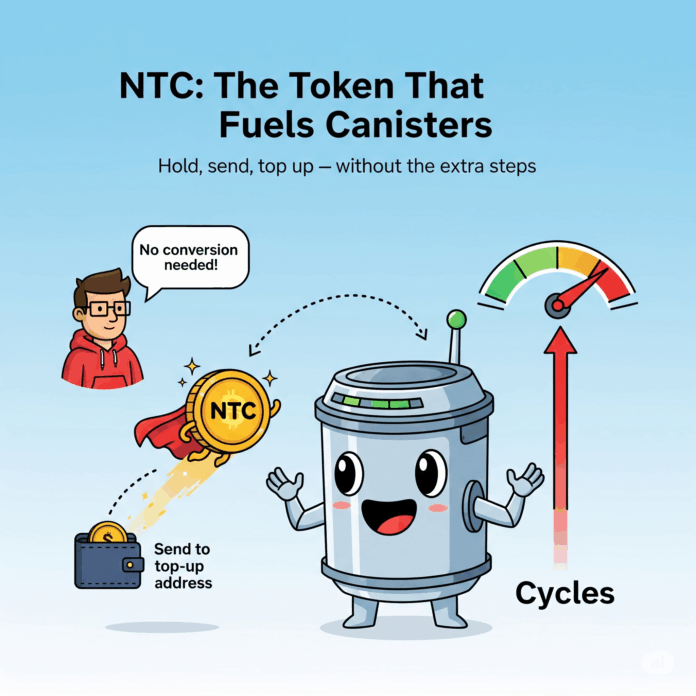A new token called NTC has been introduced as part of the StreamFusion project, offering a fresh way for developers to manage cycles on the Internet Computer. Unlike most utility tokens, NTC is designed to interact directly with the platform’s canisters, using a feature some in the community are calling its “superpower”.
Each Internet Computer (ICP) canister has a unique top-up address. By sending NTC to that address, the token is converted into cycles — the computational fuel that powers apps on the network. This design allows NTC to function both as a regular token for holding and trading, and as a direct route to replenish canisters without needing to manually convert tokens into cycles beforehand.
It’s this dual use that sets NTC apart from other project tokens. The user experience remains straightforward. NTC can be held in any compatible wallet, and no special wrapper or conversion process is needed until it’s time to top up. That moment triggers the conversion automatically, provided it’s sent to the correct canister address.
The design aims to simplify the way developers handle operational needs on the Internet Computer. Traditionally, maintaining available cycles for active canisters has required separate management tools or services. With NTC, those actions can now be tied to a token that lives comfortably within the broader ecosystem — including decentralised finance.
StreamFusion has framed NTC as the second token in its structure, reinforcing its focus on making development and deployment more manageable for teams building on ICP. This announcement follows growing interest in new utility formats that work well with the network’s existing DeFi protocols and agents. While some newer tokens struggle to find clear purpose, NTC enters the picture with a clearly defined use case that’s already familiar to developers who regularly interact with canister-level infrastructure.
Much of the appeal lies in keeping things native. There’s no bridge, no third-party offloading, and no new learning curve. NTC can be used like any other token for storage, trading or wallet transfers, and then performs a specific function when routed to the system it supports. This can help reduce friction for newer developers entering the Internet Computer ecosystem, especially those experimenting with agents or tools in Caffeine AI and similar environments.
There’s also a broader conversation happening about how best to handle resources like cycles. Some developers have suggested that this method — linking tokens directly to top-up actions — might make it easier for smaller projects to manage uptime without needing to build complex dashboards or monitoring tools. That ease of use could, over time, help improve reliability across the board.
Still, questions remain about how widely NTC will be adopted and how it might integrate with third-party protocols or services. While it works natively with the canister top-up system, interoperability with other platforms may take time to establish. For now, NTC’s value proposition is focused sharply on the Internet Computer itself, rather than spreading across multiple blockchains.
As new tools and tokens emerge within the ICP community, utility and purpose remain at the centre of the conversation. NTC joins a growing list of function-driven assets that aim to do more than just sit in a wallet. Its cycle-top-up feature is practical, immediate, and well-suited to developers running live apps.
For now, it’s clear that NTC isn’t chasing hype. Its goals are concrete, and its application straightforward. Whether it becomes widely adopted will depend on how well it holds up in real-world deployment — but as a concept, it seems well-timed for a network focused on scaling useful activity.
Dear Reader,
Ledger Life is an independent platform dedicated to covering the Internet Computer (ICP) ecosystem and beyond. We focus on real stories, builder updates, project launches, and the quiet innovations that often get missed.
We’re not backed by sponsors. We rely on readers like you.
If you find value in what we publish—whether it’s deep dives into dApps, explainers on decentralised tech, or just keeping track of what’s moving in Web3—please consider making a donation. It helps us cover costs, stay consistent, and remain truly independent.
Your support goes a long way.
🧠 ICP Principal: ins6i-d53ug-zxmgh-qvum3-r3pvl-ufcvu-bdyon-ovzdy-d26k3-lgq2v-3qe
🧾 ICP Address: f8deb966878f8b83204b251d5d799e0345ea72b8e62e8cf9da8d8830e1b3b05f
🪙 BTC Wallet: bc1pp5kuez9r2atdmrp4jmu6fxersny4uhnaxyrxau4dg7365je8sy2q9zff6p
Every contribution helps keep the lights on, the stories flowing, and the crypto clutter out.
Thank you for reading, sharing, and being part of this experiment in decentralised media.
—Team Ledger Life


